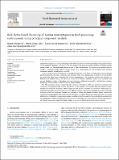Por favor, use este identificador para citar o enlazar a este item:
http://hdl.handle.net/10261/310817COMPARTIR / EXPORTAR:
 SHARE SHARE
 CORE
BASE CORE
BASE
|
|
| Visualizar otros formatos: MARC | Dublin Core | RDF | ORE | MODS | METS | DIDL | DATACITE | |

| Título: | Risk factor-based clustering of Listeria monocytogenes in food processing environments using principal component analysis |
Autor: | Nogueira, Raquel CSIC ORCID; López Cabo, Marta CSIC ORCID; García Sanmartín, Lucía CSIC ORCID; Sánchez-Ruiloba, Lucía CSIC ORCID; Rodríguez Herrera, Juan José CSIC | Palabras clave: | Listeria monocytogenes Foodborne pathogen Biofilm Principal component analysis Transference Smoked salmon Benzalkonium chloride Cell transfer Transfer Food processing environments Ready-to-eat |
Fecha de publicación: | 2023 | Editor: | Elsevier | Citación: | Food Research International 170: 112989 (2023) | Resumen: | Listeria monocytogenes has a range of strategies that allow it to persist as biofilms in food processing environments (FPE), making it a pathogen of concern to the food industry. The properties of these biofilms are highly variable among strains, and this significantly affects the risk of food contamination. The present study therefore aims to conduct a proof-of-concept study to cluster strains of L. monocytogenes by risk potential using principal component analysis, a multivariate approach. A set of 22 strains, isolated from food processing environments, were typed by serogrouping and pulsed-field gel electrophoresis, showing a relatively high diversity. They were characterized in terms of several biofilm properties that might pose a potential risk of food contamination. The properties studied were tolerance to benzalkonium chloride (BAC), the structural parameters of biofilms (biomass, surface area, maximum and average thickness, surface to biovolume ratio and roughness coefficient) measured by confocal laser scanning microscopy and (3) transfer of biofilm cells to smoked salmon. The PCA correlation circle revealed that the tolerance of biofilms to BAC was positively correlated with roughness, but negatively with biomass parameters. On the contrary, cell transfers were not related to three-dimensional structural parameters, which suggests the role of other variables yet unexplored. Additionally, hierarchical clustering grouped strains into three different clusters. One of them included the strains with high tolerance to BAC and roughness. Another one consisted of strains with enhanced transfer ability, whereas the third cluster contained those that stood out for the thickness of biofilms. The present study represents a novel and effective way to classify L. monocytogenes strains according to biofilm properties that condition the potential risk of reaching the consumer through food contamination. It would thus allow the selection of strains representative of different worst-case scenarios for future studies in support of QMRA and decision-making analysis | Descripción: | 13 pages, 8 figures, 1 table.-- Under a Creative Commons license | Versión del editor: | https://doi.org/10.1016/j.foodres.2023.112989 | URI: | http://hdl.handle.net/10261/310817 | DOI: | 10.1016/j.foodres.2023.112989 | ISSN: | 0963-9969 |
| Aparece en las colecciones: | (IIM) Artículos |
Ficheros en este ítem:
| Fichero | Descripción | Tamaño | Formato | |
|---|---|---|---|---|
| Risk_factor_based_OA_2023.pdf | 7,31 MB | Adobe PDF |  Visualizar/Abrir |
CORE Recommender
SCOPUSTM
Citations
1
checked on 21-abr-2024
Page view(s)
37
checked on 27-abr-2024
Download(s)
46
checked on 27-abr-2024
Google ScholarTM
Check
Altmetric
Altmetric
Este item está licenciado bajo una Licencia Creative Commons

